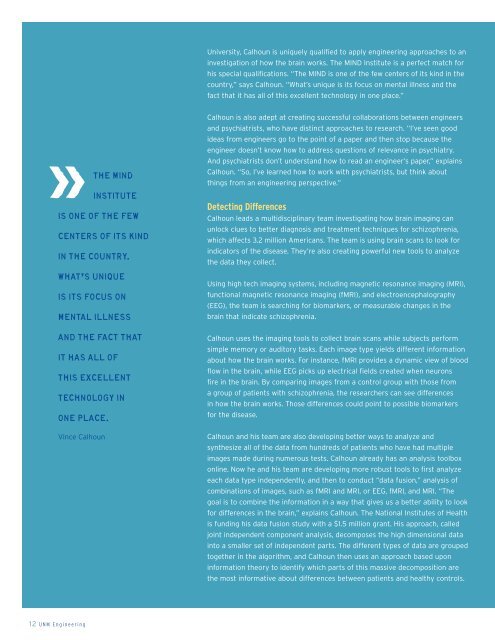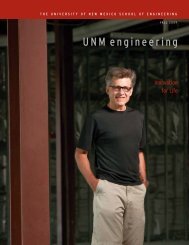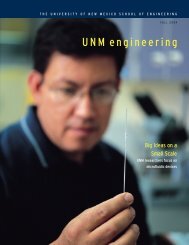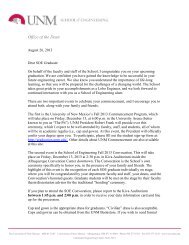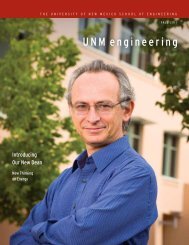UNM engineering - School of Engineering - University of New Mexico
UNM engineering - School of Engineering - University of New Mexico
UNM engineering - School of Engineering - University of New Mexico
Create successful ePaper yourself
Turn your PDF publications into a flip-book with our unique Google optimized e-Paper software.
<strong>University</strong>, Calhoun is uniquely qualified to apply <strong>engineering</strong> approaches to aninvestigation <strong>of</strong> how the brain works. The MIND Institute is a perfect match forhis special qualifications. “The MIND is one <strong>of</strong> the few centers <strong>of</strong> its kind in thecountry,” says Calhoun. “What’s unique is its focus on mental illness and thefact that it has all <strong>of</strong> this excellent technology in one place.”The MINDInstituteis one <strong>of</strong> the fewcenters <strong>of</strong> its kindin the country.What’s uniqueis its focus onmental illnessand the fact thatit has all <strong>of</strong>this excellenttechnology inone place.Vince CalhounCalhoun is also adept at creating successful collaborations between engineersand psychiatrists, who have distinct approaches to research. “I’ve seen goodideas from engineers go to the point <strong>of</strong> a paper and then stop because theengineer doesn’t know how to address questions <strong>of</strong> relevance in psychiatry.And psychiatrists don’t understand how to read an engineer’s paper,” explainsCalhoun. “So, I’ve learned how to work with psychiatrists, but think aboutthings from an <strong>engineering</strong> perspective.”Detecting DifferencesCalhoun leads a multidisciplinary team investigating how brain imaging canunlock clues to better diagnosis and treatment techniques for schizophrenia,which affects 3.2 million Americans. The team is using brain scans to look forindicators <strong>of</strong> the disease. They’re also creating powerful new tools to analyzethe data they collect.Using high tech imaging systems, including magnetic resonance imaging (MRI),functional magnetic resonance imaging (fMRI), and electroencephalography(EEG), the team is searching for biomarkers, or measurable changes in thebrain that indicate schizophrenia.Calhoun uses the imaging tools to collect brain scans while subjects performsimple memory or auditory tasks. Each image type yields different informationabout how the brain works. For instance, fMRI provides a dynamic view <strong>of</strong> bloodflow in the brain, while EEG picks up electrical fields created when neuronsfire in the brain. By comparing images from a control group with those froma group <strong>of</strong> patients with schizophrenia, the researchers can see differencesin how the brain works. Those differences could point to possible biomarkersfor the disease.Calhoun and his team are also developing better ways to analyze andsynthesize all <strong>of</strong> the data from hundreds <strong>of</strong> patients who have had multipleimages made during numerous tests. Calhoun already has an analysis toolboxonline. Now he and his team are developing more robust tools to first analyzeeach data type independently, and then to conduct “data fusion,” analysis <strong>of</strong>combinations <strong>of</strong> images, such as fMRI and MRI, or EEG, fMRI, and MRI. “Thegoal is to combine the information in a way that gives us a better ability to lookfor differences in the brain,” explains Calhoun. The National Institutes <strong>of</strong> Healthis funding his data fusion study with a $1.5 million grant. His approach, calledjoint independent component analysis, decomposes the high dimensional datainto a smaller set <strong>of</strong> independent parts. The different types <strong>of</strong> data are groupedtogether in the algorithm, and Calhoun then uses an approach based uponinformation theory to identify which parts <strong>of</strong> this massive decomposition arethe most informative about differences between patients and healthy controls.12 <strong>UNM</strong> <strong>Engineering</strong>


